
The Black Forest is a large forested mountain range in the state of Baden-Württemberg in southwest Germany, bounded by the Rhine Valley to the west and south and close to the borders with France and Switzerland. It is the source of the Danube and Neckar rivers.

Fluorite (also called fluorspar) is the mineral form of calcium fluoride, CaF2. It belongs to the halide minerals. It crystallizes in isometric cubic habit, although octahedral and more complex isometric forms are not uncommon.

The Rammelsberg is a mountain, 635 metres (2,083 ft) high, on the northern edge of the Harz range, south of the historic town of Goslar in the North German state of Lower Saxony. The mountain is the location of an important silver, copper, and lead mine. When it closed in 1988, it had been the only mine still working continuously for over 1,000 years. Because of its long history of mining and testimony to the advancement and exchange of technology over many centuries, the visitor mine of Rammelsberg was inscribed as a UNESCO World Heritage Site in 1992.

The Upper Harz Water Regale is a system of dams, reservoirs, ditches and other structures, much of which was built from the 16th to 19th centuries to divert and store the water that drove the water wheels of the mines in the Upper Harz region of Germany. The term regale, here, refers to the granting of royal privileges or rights in this case to permit the use of water for mining operations in the Harz mountains of Germany.

Mining in the Upper Harz region of central Germany was a major industry for several centuries, especially for the production of silver, lead, copper, and, latterly, zinc as well. Great wealth was accumulated from the mining of silver from the 16th to the 19th centuries, as well as from important technical inventions. The centre of the mining industry was the group of seven Upper Harz mining towns of Clausthal, Zellerfeld, Sankt Andreasberg, Wildemann, Grund, Lautenthal und Altenau.
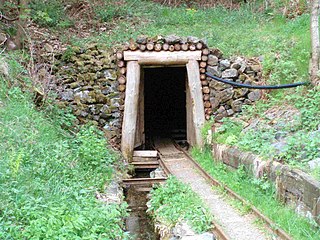
The Roter Bär Pit in Sankt Andreasberg in the Upper Harz is an iron ore mine that was worked from about 1800 until the 1860s. Today it is operated as a show mine under the name of Roter Bär Pit Educational Mine by the Sankt Andreasberg Society for History and Archaeology. The name Roter Bär means "Red Bear".
The Neuil Mine, in French Mine de Neuil, is a mine emplaced in paragneisses of the northwestern Massif Central. The mine is part of the commune of Saint-Pardoux-la-Rivière in the Dordogne. Extracted from the mine was galena, slightly enriched in silver.
The le Puy Mine is an ancient lead mine in the northwestern Massif Central, France. The mine produced mainly silver-bearing galena.
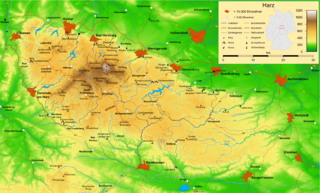
Within the Lower Harz region are still many traces of the historical water management facilities used by the mining industry. In addition to water-carrying ditches and ponds, there are also long-abandoned ditches and dry pond beds. The Lower Harz Pond and Ditch System, which forms the major part of these old water management facilities, lies in the central Lower Harz, almost entirely within the borough of the present-day town of Harzgerode.
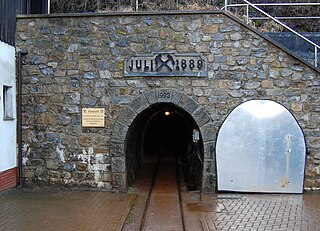
Drei Kronen & Ehrt is a former mine in the Harz Mountains of central Germany. It is located in the parish of Elbingerode in the county of Harz (Saxony-Anhalt). The mine extracted pyrite. Since 1992 it has been used, albeit not continuously, as a visitor mine.
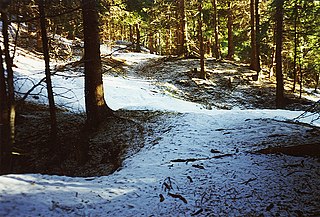
A Pinge or Binge ("binger") is the name given in German-speaking Europe to a wedge-, ditch- or funnel-shaped depression in the terrain caused by mining activity. This depression or sink-hole is frequently caused by the collapse of old underground mine workings that are close to the Earth's surface. Unlike natural landforms, a Pinge is a direct result of human activity. The term has no direct equivalent in English, but may be translated as "mining sink-hole", "mine slump" or, in some cases, as "glory hole".

The Silberberg, at 1,358.2 m above sea level (NHN), is the most prominent summit in the mountain group around the Herzogenhorn in the Black Forest in the southwest German state of Baden-Württemberg. It lies about 4 kilometres east of the town of Todtnau.

The Maaßener Gaipel is a pub catering for day trippers on the northeastern hillside of the Kranichsberg at a height of 420 m above NN, situated above the mining town of Lautenthal in the Harz Mountains of central Germany. The name goes back to the above-ground workings of the Maaßener Treibschacht or Maaßen Hoisting Shaft 51°51′49″N10°17′25″E, which was located immediately east of the inn. Gaipel is a common expression in the Upper Harz for a headframe and goes back to the use of a horse whim which in German is a Pferdegöpel. Whims were used to transport men and materiel up and down mineshafts, for example using man engines, and also to operate water management equipment. Maaßen is shorthand for the name of the local pit which was the Grube Zweite, Dritte, Vierte, Fünfte und Sechste Maß nach der Sachsenzeche. Maaß, also variously spelt Maaß, Maas or Mas, is a unit of length for a pit field (Grubenfeld) and in mining in the Upper Harz measured 28 Lachter or 53.8 metres. The pub was built in 1924 on the initiative of the Harz Club on the terrain of the old mine shaft. But decades before the area had already become a popular destination with walkers due to its views of the mining town and the valley of the Laute.
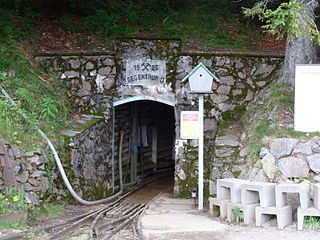
The Schauinsland Pit was a silver and lead mine east of Freiburg im Breisgau. From the 19th century zinc was also mined. The mine operated from the 13th century until 1954. Since 1997 Schauinsland Pit has been a show mine.
The BiCoNi Formation is a hydrothermal lode formation, in which bismuth, cobalt, nickel and uranium ores have coalesced. It occurs mainly in the Ore Mountains and is the youngest formation in the hydrothermal sequence. Due to its combination with uranium, it is occasionally also called the bismuth-cobalt-nickel-uranium formation.

The Clara Pit or Clara Mine is a working mine in Oberwolfach in the Black Forest in Germany in which the industrial minerals, baryte and fluorspar are mined.

MiMa is a museum of mineralogy and mathematics in Oberwolfach, in the central Black Forest in southern Germany. The museum was opened on 30 January 2010 on the site of the mineral museum after a two-year conversion and expansion phase. It is operated jointly by the municipality of Oberwolfach, the Oberwolfach Society of the Friends of Minerals and Mining and the Mathematics Research Institute, Oberwolfach.

The Caroline Pit in the Eberbächle, a side valley of the Brettenbach, is an old silver mine in Sexau in the Black Forest in Germany which is open to the public as a show mine. In 1987, volunteers began to uncover the pit and maintain it. It lies within the mining region of Sexau and Freiamt.

The Segen Gottes Show Mine is a show mine in the parish of Schnellingen in the municipality of Haslach in the Central Black Forest in Germany.

The Silbergründle Pit near Seebach in the Black Forest in Germany was a lead and silver mine.



















